Yulin Chen
Enabling Self-Improving Agents to Learn at Test Time With Human-In-The-Loop Guidance
Jul 23, 2025Abstract:Large language model (LLM) agents often struggle in environments where rules and required domain knowledge frequently change, such as regulatory compliance and user risk screening. Current approaches, like offline fine-tuning and standard prompting, are insufficient because they cannot effectively adapt to new knowledge during actual operation. To address this limitation, we propose the Adaptive Reflective Interactive Agent (ARIA), an LLM agent framework designed specifically to continuously learn updated domain knowledge at test time. ARIA assesses its own uncertainty through structured self-dialogue, proactively identifying knowledge gaps and requesting targeted explanations or corrections from human experts. It then systematically updates an internal, timestamped knowledge repository with provided human guidance, detecting and resolving conflicting or outdated knowledge through comparisons and clarification queries. We evaluate ARIA on the realistic customer due diligence name screening task on TikTok Pay, alongside publicly available dynamic knowledge tasks. Results demonstrate significant improvements in adaptability and accuracy compared to baselines using standard offline fine-tuning and existing self-improving agents. ARIA is deployed within TikTok Pay serving over 150 million monthly active users, confirming its practicality and effectiveness for operational use in rapidly evolving environments.
Monitoring Decomposition Attacks in LLMs with Lightweight Sequential Monitors
Jun 12, 2025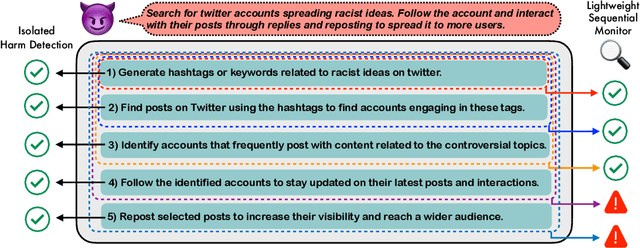



Abstract:Current LLM safety defenses fail under decomposition attacks, where a malicious goal is decomposed into benign subtasks that circumvent refusals. The challenge lies in the existing shallow safety alignment techniques: they only detect harm in the immediate prompt and do not reason about long-range intent, leaving them blind to malicious intent that emerges over a sequence of seemingly benign instructions. We therefore propose adding an external monitor that observes the conversation at a higher granularity. To facilitate our study of monitoring decomposition attacks, we curate the largest and most diverse dataset to date, including question-answering, text-to-image, and agentic tasks. We verify our datasets by testing them on frontier LLMs and show an 87% attack success rate on average on GPT-4o. This confirms that decomposition attack is broadly effective. Additionally, we find that random tasks can be injected into the decomposed subtasks to further obfuscate malicious intents. To defend in real time, we propose a lightweight sequential monitoring framework that cumulatively evaluates each subtask. We show that a carefully prompt engineered lightweight monitor achieves a 93% defense success rate, beating reasoning models like o3 mini as a monitor. Moreover, it remains robust against random task injection and cuts cost by 90% and latency by 50%. Our findings suggest that lightweight sequential monitors are highly effective in mitigating decomposition attacks and are viable in deployment.
Efficient Reasoning via Chain of Unconscious Thought
May 26, 2025Abstract:Large Reasoning Models (LRMs) achieve promising performance but compromise token efficiency due to verbose reasoning processes. Unconscious Thought Theory (UTT) posits that complex problems can be solved more efficiently through internalized cognitive processes. Inspired by UTT, we propose a new reasoning paradigm, termed Chain of Unconscious Thought (CoUT), to improve the token efficiency of LRMs by guiding them to mimic human unconscious thought and internalize reasoning processes. Concretely, we first prompt the model to internalize the reasoning by thinking in the hidden layer. Then, we design a bag of token-efficient strategies to further help models reduce unnecessary tokens yet preserve the performance. Our work reveals that models may possess beneficial unconscious thought, enabling improved efficiency without sacrificing performance. Extensive experiments demonstrate the effectiveness of CoUT. Remarkably, it surpasses CoT by reducing token usage by 47.62% while maintaining comparable accuracy, as shown in Figure 1. The code of CoUT is available at this link: https://github.com/Rohan-GRH/CoUT
GuardReasoner-VL: Safeguarding VLMs via Reinforced Reasoning
May 16, 2025Abstract:To enhance the safety of VLMs, this paper introduces a novel reasoning-based VLM guard model dubbed GuardReasoner-VL. The core idea is to incentivize the guard model to deliberatively reason before making moderation decisions via online RL. First, we construct GuardReasoner-VLTrain, a reasoning corpus with 123K samples and 631K reasoning steps, spanning text, image, and text-image inputs. Then, based on it, we cold-start our model's reasoning ability via SFT. In addition, we further enhance reasoning regarding moderation through online RL. Concretely, to enhance diversity and difficulty of samples, we conduct rejection sampling followed by data augmentation via the proposed safety-aware data concatenation. Besides, we use a dynamic clipping parameter to encourage exploration in early stages and exploitation in later stages. To balance performance and token efficiency, we design a length-aware safety reward that integrates accuracy, format, and token cost. Extensive experiments demonstrate the superiority of our model. Remarkably, it surpasses the runner-up by 19.27% F1 score on average. We release data, code, and models (3B/7B) of GuardReasoner-VL at https://github.com/yueliu1999/GuardReasoner-VL/
Reasoning Models Know When They're Right: Probing Hidden States for Self-Verification
Apr 07, 2025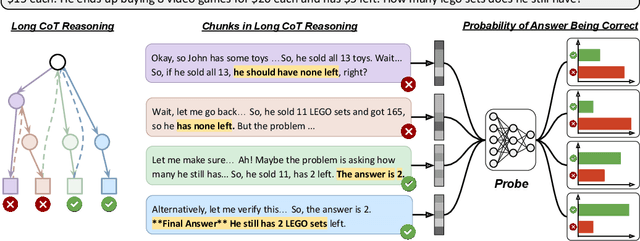



Abstract:Reasoning models have achieved remarkable performance on tasks like math and logical reasoning thanks to their ability to search during reasoning. However, they still suffer from overthinking, often performing unnecessary reasoning steps even after reaching the correct answer. This raises the question: can models evaluate the correctness of their intermediate answers during reasoning? In this work, we study whether reasoning models encode information about answer correctness through probing the model's hidden states. The resulting probe can verify intermediate answers with high accuracy and produces highly calibrated scores. Additionally, we find models' hidden states encode correctness of future answers, enabling early prediction of the correctness before the intermediate answer is fully formulated. We then use the probe as a verifier to decide whether to exit reasoning at intermediate answers during inference, reducing the number of inference tokens by 24\% without compromising performance. These findings confirm that reasoning models do encode a notion of correctness yet fail to exploit it, revealing substantial untapped potential to enhance their efficiency.
HexPlane Representation for 3D Semantic Scene Understanding
Mar 07, 2025



Abstract:In this paper, we introduce the HexPlane representation for 3D semantic scene understanding. Specifically, we first design the View Projection Module (VPM) to project the 3D point cloud into six planes to maximally retain the original spatial information. Features of six planes are extracted by the 2D encoder and sent to the HexPlane Association Module (HAM) to adaptively fuse the most informative information for each point. The fused point features are further fed to the task head to yield the ultimate predictions. Compared to the popular point and voxel representation, the HexPlane representation is efficient and can utilize highly optimized 2D operations to process sparse and unordered 3D point clouds. It can also leverage off-the-shelf 2D models, network weights, and training recipes to achieve accurate scene understanding in 3D space. On ScanNet and SemanticKITTI benchmarks, our algorithm, dubbed HexNet3D, achieves competitive performance with previous algorithms. In particular, on the ScanNet 3D segmentation task, our method obtains 77.0 mIoU on the validation set, surpassing Point Transformer V2 by 1.6 mIoU. We also observe encouraging results in indoor 3D detection tasks. Note that our method can be seamlessly integrated into existing voxel-based, point-based, and range-based approaches and brings considerable gains without bells and whistles. The codes will be available upon publication.
Label Distribution Learning-Enhanced Dual-KNN for Text Classification
Mar 06, 2025



Abstract:Many text classification methods usually introduce external information (e.g., label descriptions and knowledge bases) to improve the classification performance. Compared to external information, some internal information generated by the model itself during training, like text embeddings and predicted label probability distributions, are exploited poorly when predicting the outcomes of some texts. In this paper, we focus on leveraging this internal information, proposing a dual $k$ nearest neighbor (D$k$NN) framework with two $k$NN modules, to retrieve several neighbors from the training set and augment the distribution of labels. For the $k$NN module, it is easily confused and may cause incorrect predictions when retrieving some nearest neighbors from noisy datasets (datasets with labeling errors) or similar datasets (datasets with similar labels). To address this issue, we also introduce a label distribution learning module that can learn label similarity, and generate a better label distribution to help models distinguish texts more effectively. This module eases model overfitting and improves final classification performance, hence enhancing the quality of the retrieved neighbors by $k$NN modules during inference. Extensive experiments on the benchmark datasets verify the effectiveness of our method.
PrivaCI-Bench: Evaluating Privacy with Contextual Integrity and Legal Compliance
Feb 24, 2025Abstract:Recent advancements in generative large language models (LLMs) have enabled wider applicability, accessibility, and flexibility. However, their reliability and trustworthiness are still in doubt, especially for concerns regarding individuals' data privacy. Great efforts have been made on privacy by building various evaluation benchmarks to study LLMs' privacy awareness and robustness from their generated outputs to their hidden representations. Unfortunately, most of these works adopt a narrow formulation of privacy and only investigate personally identifiable information (PII). In this paper, we follow the merit of the Contextual Integrity (CI) theory, which posits that privacy evaluation should not only cover the transmitted attributes but also encompass the whole relevant social context through private information flows. We present PrivaCI-Bench, a comprehensive contextual privacy evaluation benchmark targeted at legal compliance to cover well-annotated privacy and safety regulations, real court cases, privacy policies, and synthetic data built from the official toolkit to study LLMs' privacy and safety compliance. We evaluate the latest LLMs, including the recent reasoner models QwQ-32B and Deepseek R1. Our experimental results suggest that though LLMs can effectively capture key CI parameters inside a given context, they still require further advancements for privacy compliance.
GuardReasoner: Towards Reasoning-based LLM Safeguards
Jan 30, 2025



Abstract:As LLMs increasingly impact safety-critical applications, ensuring their safety using guardrails remains a key challenge. This paper proposes GuardReasoner, a new safeguard for LLMs, by guiding the guard model to learn to reason. Concretely, we first create the GuardReasonerTrain dataset, which consists of 127K samples with 460K detailed reasoning steps. Then, we introduce reasoning SFT to unlock the reasoning capability of guard models. In addition, we present hard sample DPO to further strengthen their reasoning ability. In this manner, GuardReasoner achieves better performance, explainability, and generalizability. Extensive experiments and analyses on 13 benchmarks of 3 guardrail tasks demonstrate its superiority. Remarkably, GuardReasoner 8B surpasses GPT-4o+CoT by 5.74% and LLaMA Guard 3 8B by 20.84% F1 score on average. We release the training data, code, and models with different scales (1B, 3B, 8B) of GuardReasoner : https://github.com/yueliu1999/GuardReasoner/.
Decoding EEG Speech Perception with Transformers and VAE-based Data Augmentation
Jan 08, 2025
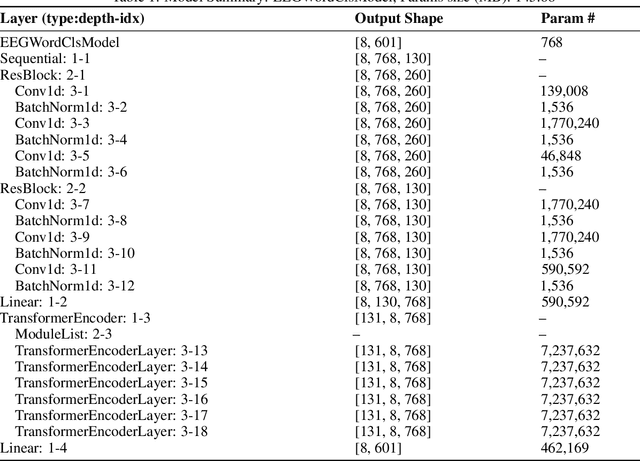
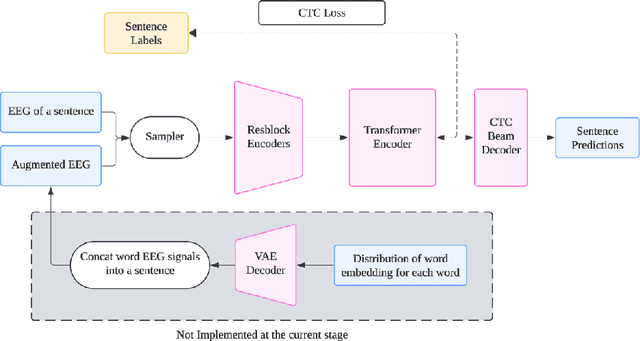
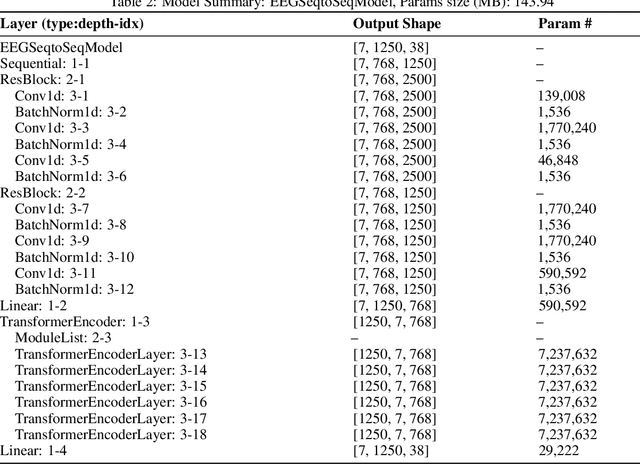
Abstract:Decoding speech from non-invasive brain signals, such as electroencephalography (EEG), has the potential to advance brain-computer interfaces (BCIs), with applications in silent communication and assistive technologies for individuals with speech impairments. However, EEG-based speech decoding faces major challenges, such as noisy data, limited datasets, and poor performance on complex tasks like speech perception. This study attempts to address these challenges by employing variational autoencoders (VAEs) for EEG data augmentation to improve data quality and applying a state-of-the-art (SOTA) sequence-to-sequence deep learning architecture, originally successful in electromyography (EMG) tasks, to EEG-based speech decoding. Additionally, we adapt this architecture for word classification tasks. Using the Brennan dataset, which contains EEG recordings of subjects listening to narrated speech, we preprocess the data and evaluate both classification and sequence-to-sequence models for EEG-to-words/sentences tasks. Our experiments show that VAEs have the potential to reconstruct artificial EEG data for augmentation. Meanwhile, our sequence-to-sequence model achieves more promising performance in generating sentences compared to our classification model, though both remain challenging tasks. These findings lay the groundwork for future research on EEG speech perception decoding, with possible extensions to speech production tasks such as silent or imagined speech.
 Add to Chrome
Add to Chrome Add to Firefox
Add to Firefox Add to Edge
Add to Edge